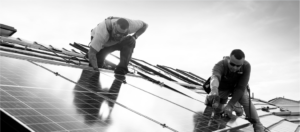(aka – Scaled Back ‘Build Back Better’)
President Biden signed into law the Inflation Reduction Act today. Whether you agree with the title of the bill, it includes sweeping changes for the solar industry, electric vehicles, and the environment. The vote passed 50/50 in the Senate under Reconciliation Procedures, with Vice President Harris casting the tie-breaking vote, and easily passed in the House of Representatives. President Biden then signed the bill into law this morning.
This bill is arguably a smaller and more targeted ‘Build Back Better’, which has many of the same goals. It allocates up to $730 billion on various goals, including allocating $370 billion on climate change and clean energy production, as well as boosting US energy production. It provides incentives for households and private companies to shift to renewable energy, and adjust consumption. This will have a major impact on the Solar Industry, as well as jump-start the transition to large-scale deployment in battery storage for renewables.
Specific to the Solar Industry, the new law has the following major provisions:
- The ITC Solar Investment Tax Credit increased; from 26% to 30%. The credit will last until 2032, for a full 10 years!
- The credit may now be transferred or sold to other taxpayers, and can be applied to both residential and business projects.
- Energy Storage Projects will now receive the full tax credit of 30%. Previously, some projects had difficulty meeting certain requirements, and this new law removed many of those. Batteries connected to a solar project will qualify, even if no longer being charged by solar power.
- Interconnection Costs are now INCLUDED in the tax credit, for projects up to 5 MWac.
- The tax credit could increase an additional 10%, to 40% total; provided the project utilized domestically produced hardware. In addition, projects sited in ‘former energy communities’ (associated with fossil fuels) the project could earn another additional 10% tax credit.
Specific to the battery electric vehicles, the new law has the following major provisions:
- The new EV Tax Credit set to $7500 for a new EV or Hybrid, and there were provisions for a $4000 tax credit on the purchase of a used, qualified vehicle. The credit will be in effect for 10 years.
- Many improvements for EV Tax Credits, that make the credit easier and more available, but focusing on domestic production of EVs.
- EVs assembled outside North America will no longer qualify, income thresholds imposed, and maximum pricing for sedans and hatchbacks ($55,000) and SUVs, trucks, and vans ($80,000).
- ‘Commercial Clean Vehicles’, like the new Tesla Semi, will also qualify for up to $40,000 in incentives.
- Provisions for starting in 2024 for at least 50% of the EV batteries to be sourced from USA, Canada, or Mexico, and rising to 100% by 2028.
- NOTE: The incentive is now also applicable to plug in and non-plug in hybrid vehicles, if the battery pack is at least 5.0 kWh in size, and is therefore not exclusive to fully battery powered electric vehicles.
Funding for the bill is through new tax provisions, prescription drug pricing reform, and on increased IRS tax enforcement. This includes a mandatory 15% corporate minimum tax on large corporations. There is much debate as to whether the new law will bring down inflation, but there is definitely has major incentives and benefits to promote renewable energy and the electrification of the US Vehicle fleet. These steps should lead to drastic improvements to the environment, the climate, and the stability of our energy grid.
References:
H.R.5376 – Inflation Reduction Act of 2022
— —
Written by: Glenn Hall & Alex Pugh, AEE Solar Applications Engineers

